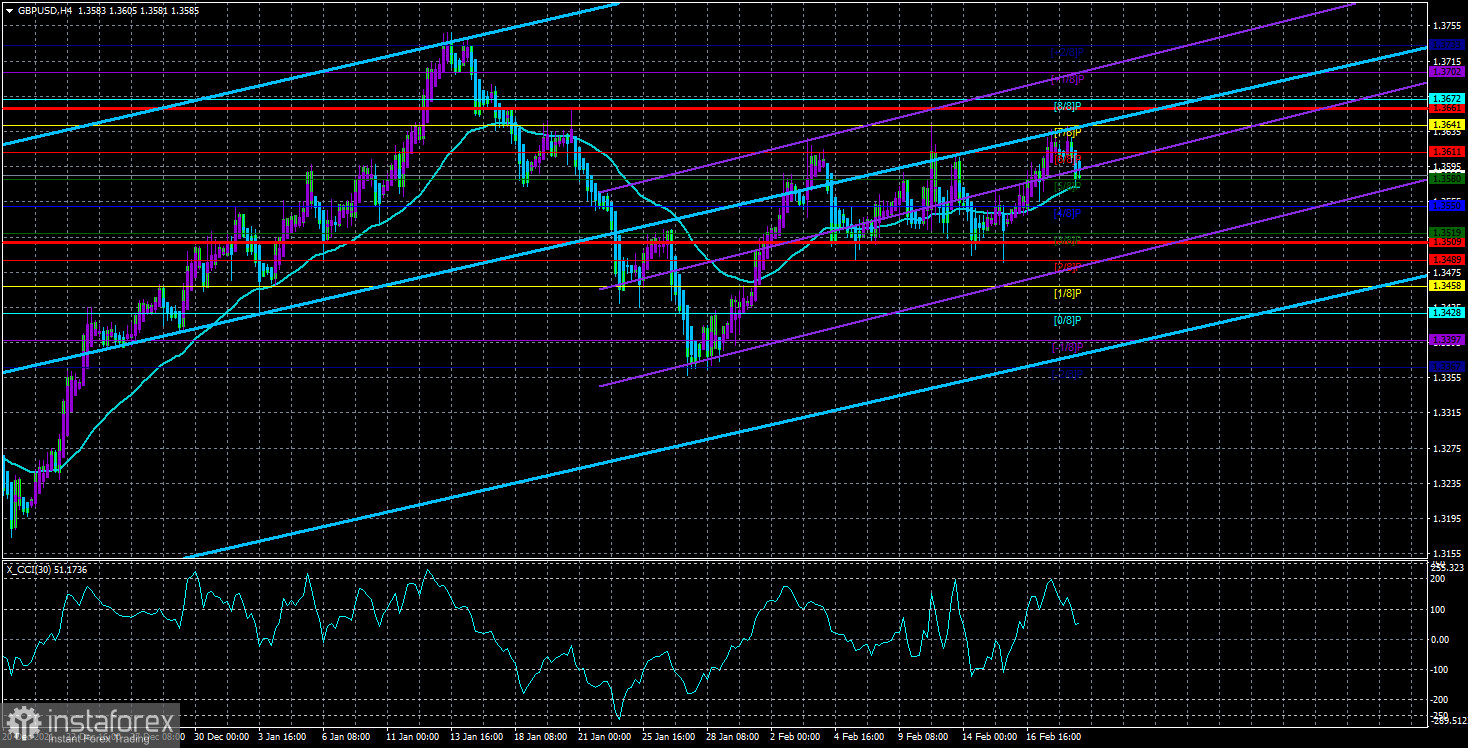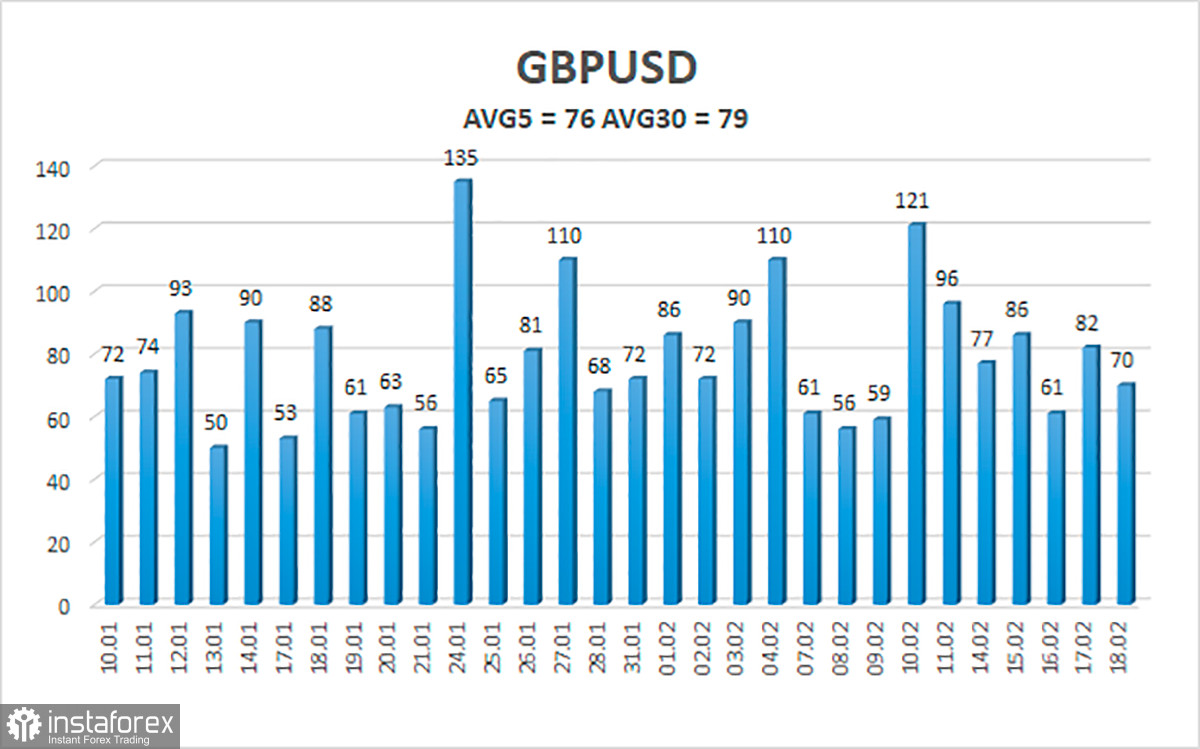
The GBP/USD currency pair tried to continue moving up on Friday, but by the end of the day, the bulls still retreated from the market. Thus, it may seem that there is an upward trend in the pound/dollar pair now, but we would like to draw attention to the fact that the price rose for the second time to the level of 1.3641 and rebounded from it for the second time. It has been between the levels of 1.3489 and 1.3641 for several weeks. Of course, 150 points are not exactly a side channel, nevertheless, the price is in a limited side range. And we believe that the probability of a flat is now higher than the probability of an upward movement. Earlier, we have already figured out why the pound, in principle, now has a better chance of growth than the euro currency. Similarly, it has less chance of falling against the dollar than the euro. The only one to thank for this is the Bank of England, which has already raised the key rate twice. But at the same time, the factor of geopolitics can have a serious impact on the mood of traders. For example, if there are signs of deterioration of the geopolitical situation in Ukraine in the new week, this may cause additional demand for the dollar on world markets. Investors will simply withdraw their capital from stocks, indices, and cryptocurrencies, as well as from the economies of countries that may be under sanctions or be involved in a military conflict and move them into dollars and safe assets. Therefore, from our point of view, now the level of 1.3641 is of great importance. If it is overcome on Monday or Tuesday, then the flat will be canceled, and the upward movement can continue. The only question is, how long will it last? If it is not overcome, then either a flat with a fall to the lower border of the channel 1.3489 or a new downward trend.
Preview for the new week.
There will be very few macroeconomic publications and fundamental events in the new week. In the UK, business activity indices in the services and manufacturing sectors will be published on Monday, and there is no danger here, since both are located above the 50.0 mark, below which it is believed that the corresponding industry is slowing down. Thus, if there is no collapse of these indices, we believe that they will be ignored. On Tuesday, similar indices will be published in the States, and here the index for the service sector may fall below 50.0. If this happens, the dollar may experience problems for some time, but it is unlikely to be serious and for a long time. On Thursday, the US will release a report on GDP for the fourth quarter in the second assessment. Traders are already ready to see +6.9% (the first estimate), so there will most likely be no differences from the forecast, and there will most likely be no reaction either. On Friday, the US will release an index of personal consumption expenditures, changes in income levels, and expenditures of the country's population, as well as orders for long-term goods. All are secondary in the current circumstances. Naturally, Joe Biden, Boris Johnson, and even Jerome Powell will probably make speeches several times during the week. Although, as for the first two persons, they will comment on the difficult geopolitical situation in Eastern Europe, and not on the economy of their countries. Therefore, we believe that during the current week, the geopolitical background will remain in the first place and much will depend on the escalation or de-escalation of the Ukraine-Russia conflict. Unfortunately, now we can say that the conflict is escalating, and not vice versa. For several days in a row, shelling has been observed in the Donetsk and Luhansk regions; the evacuation of the local population to Russia began the day before yesterday. It is unlikely that these facts, which are facts, indicate an improvement in the situation.

The average volatility of the GBP/USD pair is currently 76 points per day. For the pound/dollar pair, this value is "average". On Monday, February 21, thus, we expect movement inside the channel, limited by the levels of 1.3509 and 1.3661. The reversal of the Heiken Ashi indicator downwards signals a new round of upward movement within the framework of the "swing".
Nearest support levels:
S1 – 1.3580
S2 – 1.3550
S3 – 1.3519
Nearest resistance levels:
R1 – 1.3611
R2 – 1.3641
R3 – 1.3672
Trading recommendations:
The GBP/USD pair on the 4-hour timeframe continues to trade near the moving in the "swing" mode. Thus, at this time, it is possible to consider long positions with targets of 1.3641 and 1.3661 in case of a rebound from the moving, but one should take into account the high probability of a flat and a hike to 1.3489. It is recommended to consider short positions if the pair is fixed back below the moving average, with targets of 1.3519 and 1.3489.
Explanations to the illustrations:
Linear regression channels - help determine the current trend. If both are directed in the same direction, then the trend is strong now.
Moving average line (settings 20.0, smoothed) - determines the short-term trend and the direction in which trading should be conducted now.
Murray levels - target levels for movements and corrections.
Volatility levels (red lines) - the likely price channel in which the pair will spend the next day, based on current volatility indicators.
CCI indicator - its entry into the oversold area (below -250) or into the overbought area (above +250) means that a trend reversal in the opposite direction is approaching.





















